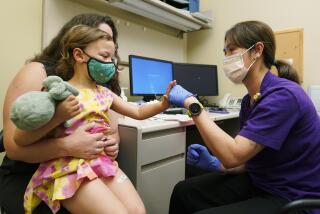Tiny Task Captivates Therapists : Medical: Physical therapists are working to tone the muscles of premature infants to help prevent developmental problems later.
James sucks on a glove. That’s a good sign.
Encouraging James’ tongue and jaw muscles to suck on a gloved hand is part of the treatment from his therapist. He needs a therapist, not as the victim of an accident or stroke, but as a baby born 11 weeks too soon.
“Everything we’re doing is preventive,” said Penny Erickson, James Zazueta’s occupational therapist at Kaiser Foundation Hospital in Woodland Hills.
Occupational and physical therapists guide adult patients back into normal lives, but as medical advances save younger and sicker babies, specialists’ attention has expanded to include infants too sick to move or born so prematurely they did not fully develop their muscle and nerve systems in the womb.
“Their muscle tone tends to be weak, hurting their ability to roll over and sit up,” Erickson said of her tiny charges. “If they don’t develop muscle tone, they may later have problems with writing and fine-muscle tasks.”
Abnormal muscle tone is the major non-medical developmental problem for babies. At a stage when hands and mouths are their main means of exploring the world, infants’ neuromuscular development is vital for a normal rate of growth.
James, having lost maturation time in his mother’s womb, was born unable to suck, bend his knees or grasp with his fingers, all normal tasks for a full-term infant.
In the womb, infants first develop the ability to extend their muscles. Later, the increasingly cramped quarters of the uterus in the last few weeks of gestation forces them to flex their muscles and limbs toward the front of their bodies. Premature infants who are unable to flex their muscles are born with their necks and spines extended back. Without the strength to lift them against the force of gravity, their arms and legs lie flat, instead of curling up and flailing about as do those of full-term infants.
“What happens to them is absolutely the antithesis of what you would like to happen to them,” said Erin Keane-Porter, an occupational therapist at AMI Medical Center of Tarzana.
Preemies and sick infants are evaluated to determine where the occupational or physical therapy is needed. Some are stroked--almost like the adult version of a massage--for about 20 minutes each day. The soothing, stroking motions may be repeated on their arms so that they can be helped to move their thumbs up to be sucked, one of the ways that babies comfort themselves. Tiny hands need stroking by an adult’s finger to encourage grasping. Legs might be gently flexed. The preemies may be held in positions that facilitate movement of their limbs. Rolled blankets may be placed against their backs to encourage curling in the fetal position.
The touch and movement stimulates the infant’s nerves, which in turn message the brain. The activity matures the brain and nervous system, and it helps muscles to function properly. As babies use their muscles more, their movements become less jerky. Although many preemies do well without this therapy, their mental and physical growth may be slower, therapists say.
First used about 15 years ago, the therapy has become more common in hospitals partly because technology has saved more premature babies than before.
“Technology has progressed. They’re saving more and more infants, younger infants and sicker infants,” said Ann Hyde, an occupational therapist at Glendale Adventist Medical Center. “Those children are at a higher risk with development later on.”
Not all medical specialists are convinced that skin and muscle stimulation is beneficial. Although they are among believers in the treatment, Erickson and Hyde said no study has shown conclusively that tactile stimulation works. In addition, experts in the field said attributing babies’ improvement to such therapy alone would be difficult because so many factors have to be considered, including the use of machines and drugs.
“There are no studies that show it works, but there are no studies to show that it doesn’t,” said Dr. Tom Sherry, director of the neonatal intensive care unit at the Kaiser hospital. “There are a lot of things in medicine like that. We’d rather do it than find out later we should have. I’m more willing to use it, but I’m just as skeptical.”
Sherry said some muscletone problems that are resolved by 12 months probably would have disappeared without intervention. But he said sick infants, such as those with neurological problems, definitely improve with the therapy.
One study by the University of Miami and Duke University medical schools about six years ago concluded that babies given the therapy gain weight faster, sleep better, are more alert and leave the hospital six days earlier, saving the hospital an average of $3,000 per infant. Other studies by medical schools, doctors and therapists showed that such stimulation appeared effective, but they cautioned that more investigation is needed.
Hyde said the therapy really caught on in the last five years. “I get calls all the time from other hospitals saying that the neonatal intensive care unit wants training for therapists,” she said. In the last year, Hyde received calls from about 10 hospitals asking for Glendale’s training program, which teaches therapists how to evaluate babies’ reactions to the stimulation.
At Glendale, gentle stimulation is given to about 98% of the babies in the intensive care unit, which admits about 200 sick and premature infants each year, Hyde said.
In the long run, some care givers said, early intervention therapy saves medical costs, such as charges for surgery or for equipment to rectify developmental problems.
Erickson stuck her hands inside James’ incubator. That morning, at 33 weeks since conception, the baby weighed 3 pounds, 2 ounces, almost a pound more than at birth four weeks before. A respirator tube was in his mouth and an intravenous tube in his foot.
Erickson flexed James’ legs, watching to see whether they would recoil, the reaction of a full-term infant when its legs are tugged. But although the therapist felt the movement of a tiny tendon in James’ foot, his legs dropped like lifeless objects.
“Real weak, but he’s responding much more than two days ago,” said Erickson, who has helped organize treatment programs at four hospitals since 1985.
Over the years, James, like many other preemies and sick infants, will probably be brought back to therapists for checkups on his balance, motor skills and how he solves problems such as fitting together the pieces of a puzzle. Developmental problems may take a long time to disappear, and treatment is often required into young adulthood, therapists say.
Parents like Pamela Jenkins are taught to continue the therapy after the baby goes home. Jenkins, who worked with her daughter at home for a year, was at first scared of hurting her baby, who was born with neurological problems. “I was scared because my child’s muscles were so tight. She cried a lot when I did the exercises in the beginning. With her not being able to talk, I didn’t know whether she was hurting.”
Jenkins now believes that the therapy saved her from high expenses for corrective and medical treatments and from a life of serving a child who was unable to care for her own needs.
“From what the doctors were telling me, I thought I had to dedicate my life in taking care of her,” Jenkins said. “When she was born, I was told if she lasted through the night, that was good. The first time I ever saw her, she was hooked up to quite a few machines. Her mouth was taped, and she had a tube going down her stomach. She didn’t hardly move at all. She was big in size, eight pounds, but she was lifeless to me.
“To see her now--I still look at the pictures of her when she was at the hospital--you would not believe that she was the same child.”
Hospitals encourage parents to start working with premature or ill newborns when the babies are still in incubators.
“The parents start focusing on the monitors, watching the numbers and not looking at what their baby is doing,” Erickson said. “We want them to start looking at the baby and at how the baby is responding to them. We want to get the parents bonded to the babies, handling them, feeding them, changing their diapers.
“Most of the parents involved are very receptive to doing any kind of exercise or handling. A lot of it is just natural.”






